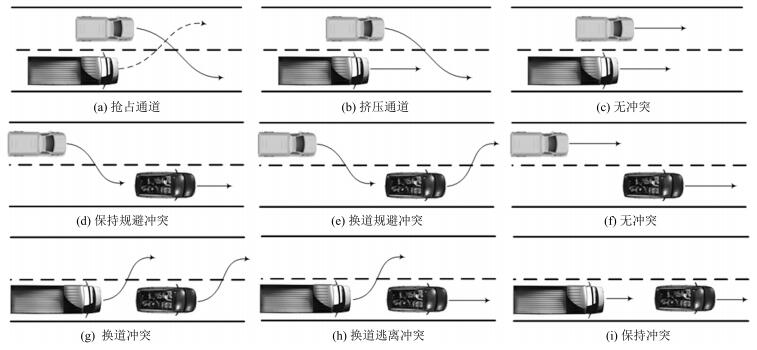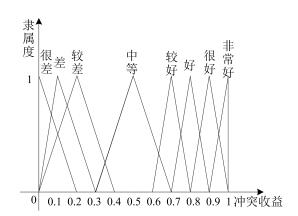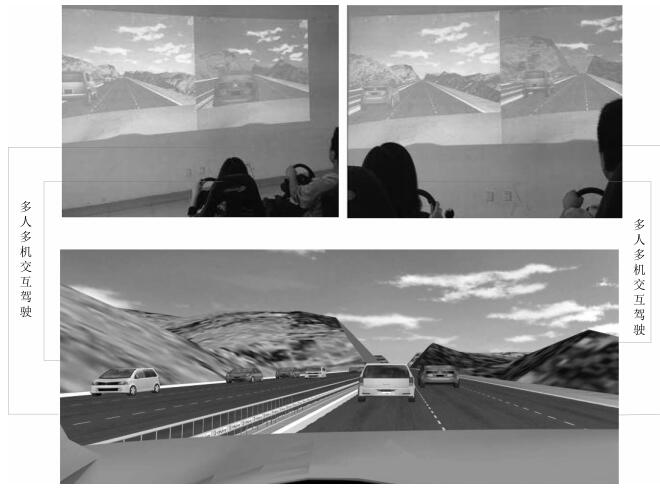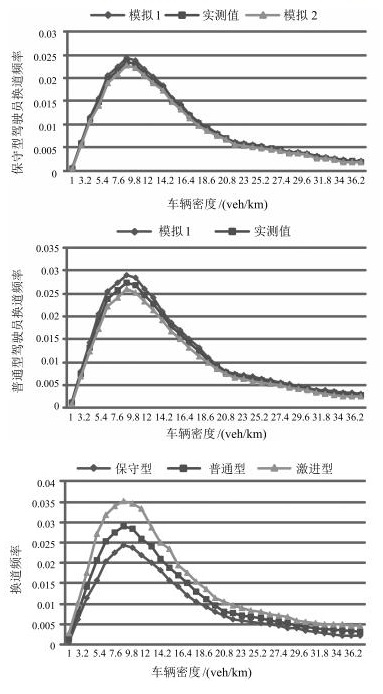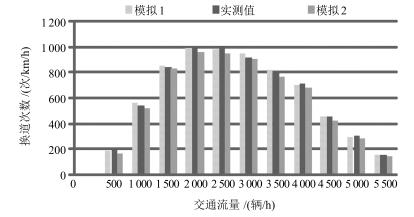Drivers' Lane Choice Model Based on Mixed Fuzzy Multi-person and Multi-objective Non-cooperative Game
-
摘要: 建立汽车安全驾驶辅助系统(包括安全驾驶预警系统)是保证交通安全的有效手段.准确预测车辆集群态势是汽车安全辅助驾驶的前提,车道选择是车辆集群态势发生转移最为根本的原因,也是交通流理论研究的基本内容.以往研究没有综合考虑车辆集群复杂态势下各运动实体特征及其操控者类型,以及多个车道间车辆的冲突对车道选择的影响.为此,本文综合考虑各运动实体特征及其操控者类型,基于混合模糊多人多目标非合作博弈方法,建立城市快速路基本路段上的驾驶员车道选择模型.通过分析各方驾驶员在不同车道选择策略下的收益,确定换道博弈的Nash均衡,得到驾驶员最优车道选择策略.研究结果表明:基于混合模糊多人多目标非合作博弈方法建构的驾驶员车道选择模型,其预测准确率可达到85.2%.Abstract: Vehicle safety driving assistance system (including driving safety alerting system) is an effective means to ensure traffic safety while accurate prediction of vehicle cluster situation is the premise of automobile safety assistant driving system. The drivers' lane choice process is not only the root cause of the transformation of vehicle cluster situation, but also the basic topic of traffic flow research. Previous studies do not synthetically consider the characteristics of individual traffic entities and the types of manipulators under the complex vehicle cluster situation, neither the influence of vehicles conflicts under multiple lanes on lane choice is taken into account. Therefore, in this paper, considering the types of vehicle manipulators and the characteristics of each movement entity, the model of drivers' lane choice on basic segment of urban expressway is built based on mixed fuzzy multi-person and multi-objective non-cooperative game. Drivers' profits under the different combinations of lane choice behaviors are analyzed, Nash equilibrium in the game process is confirmed, and the drivers' optimal lane choice strategy in a dynamic game is obtained. The results show that the model's prediction accuracy of lane change reaches 85.2%.1) 本文责任编委 董海荣
-
表 1 不同类型驾驶员感知各分区域车辆对目标车综合作用力的贡献率
Table 1 Contribution rates of integrated force from different types of drivers in sub-area to the target vehicle
目标车位置 目标车位于左车道 目标车位于中间车道 目标车位于右车道 贡献率驾驶员类型 $\xi _i^{ql}$ $\xi _i^{hl}$ $\xi _i^{lyq}$ $\xi _i^{lyq}$ $\xi _i^{gyq}$ $\xi _i^{gyh}$ $\xi _i^q $ $\xi _i^h $ $\xi _i^{zq} $ $\xi _i^q $ $\xi _i^h $ $\xi _i^{zq} $ $\xi _i^{ql} $ $\xi _i^{hl} $ $\xi _i^{lyq} $ $\xi _i^{lyq} $ $\xi _i^{gyq} $ $\xi _i^{gyh} $ 激进型 0.244 0.161 0.186 0.226 0.086 0.097 0.219 0.152 0.166 0.219 0.152 0.166 0.244 0.161 0.186 0.226 0.086 0.097 普通型 0.251 0.201 0.181 0.193 0.081 0.093 0.226 0.187 0.152 0.226 0.187 0.152 0.251 0.201 0.181 0.193 0.081 0.093 保守型 0.265 0.236 0.173 0.168 0.076 0.082 0.241 0.191 0.111 0.241 0.191 0.111 0.265 0.236 0.173 0.168 0.076 0.082 表 2 冲突收益语义项与三角形模糊数之间的对应关系
Table 2 Correspondence between semantic driving conflict items and triangular fuzzy numbers
冲突收益评价语义项 三角形模糊数 冲突收益评价语义项 三角形模糊数 很差 (0, 0, 0.2) 较好 (0.6, 0.7, 0.8) 差 (0, 0.1, 0.3) 好 (0.7, 0.8, 0.9) 较差 (0, 0.2, 0.4) 很好 (0.8, 0.9, 1) 中等 (0.3, 0.5, 0.7) 非常好 (0.9, 1, 1) 表 3 不同类型驾驶员对各收益的模糊权重情况
Table 3 Fuzzy weight of the beneflt for difierent types of drivers
驾驶员类型 模糊权重 行车安全收益${\not{\omega }}_i^1 $ 行车时间收益${\not{\omega }}_i^2$ 冲突收益${\not{\omega }}_i^3 $ 激进型 0.3 0.5 0.2 普通型 0.35 0.4 0.25 保守型 0.4 0.3 0.3 表 4 实验可采集数据
Table 4 Collected experiment data types
数据 目标车与周围车辆相对距离(m) 目标车与周围车辆相对速度(m/s) 左前车 左后车 前车 后车 右前车 右后车 左前车 左后车 前车 后车 右前车 右后车 代码 $\Delta d_2 $ $\Delta d_3 $ $\Delta d_4 $ $\Delta d_5$ $\Delta d_6 $ $\Delta d_7 $ $\Delta v_2 $ $\Delta v_3 $ $\Delta v_4 $ $\Delta v_5 $ $\Delta v_6 $ $\Delta v_7 $ 表 5 车道选择模型参数标定
Table 5 Parameter calibration of lane choice model
参数 $v_1 $ $v_2 $ $v_3 $ $v_4 $ $d_1 $ $d_2 $ $d_3 $ $d_4 $ 数值 激进型 -3.2 -1.7 1.7 3.2 8.3 22.4 36.2 50.5 普通型 -4.8 -2.5 2.5 4.8 12.6 25.8 40.1 60.5 保守型 -8.7 -4.5 4.5 8.7 22.7 35.3 50.5 70.5 表 6 道路实车实验结果
Table 6 Verification results of actual driving experiment
驾驶员编号 预测次数 预测结果与实测结果对比 准确率(%) 相符次数 不符次数 1 80 71 9 88.8 2 80 68 12 85.0 3 80 67 13 83.8 4 80 69 11 86.3 5 80 65 15 81.3 6 80 67 13 83.8 7 80 70 10 87.5 8 80 68 12 85.0 均值 80 68.125 11.875 85.16 表 7 驾驶模拟实验结果
Table 7 Verification results of virtual driving experiment
驾驶员编号 预测次数 预测结果与实测结果对比 准确率(%) 相符次数 不符次数 1 80 70 10 87.5 2 80 69 11 86.3 3 80 66 14 82.5 4 80 71 9 88.8 5 80 67 13 83.8 6 80 70 10 87.5 7 80 65 15 81.3 8 80 68 12 85.0 均值 80 68.25 11.75 85.31 表 8 微观仿真结果与实测数据对比分析表
Table 8 Comparative analysis of microscopic simulation and measured values
评价指标 实测值 模拟1结果 误差(%) 平均速度(m/s) 10.2 10.66 4.51 平均密度(辆/km) 19.3 18.52 4.04 平均延误(s) 7.2 6.93 3.75 -
[1] Gipps P G. A model for the structure of lane-changing decisions. Transportation Research Part B:Methodological, 1986, 20(5):403-414 doi: 10.1016/0191-2615(86)90012-3 [2] Hidas P. Modelling lane changing and merging in microscopic traffic simulation. Transportation Research Part C:Emerging Technologies, 2002, 10(5-6):351-371 doi: 10.1016/S0968-090X(02)00026-8 [3] Halati A, Lieu H, Walker S. CORSIM-corridor traffic simulation model. In:Proceedings of the 1997 Traffic Congestion and Traffic Safety in the 21st Century:Challenges, Innovations, and Opportunities. New York, USA:American Society of Civil Engineers, 1997. 570-576 https://www.mendeley.com/research-papers/corsim-corridor-traffic-simulation-model/ [4] Yang Q, Koutsopoulos H N. A microscopic traffic simulator for evaluation of dynamic traffic management systems. Transportation Research Part C:Emerging Technologies, 1996, 4(3):113-129 doi: 10.1016/S0968-090X(96)00006-X [5] Ahmed K I. Modeling Drivers' Acceleration and Lane Changing Behavior[Ph.D. dissertation], Massachusettes Institute of Technology, America, 1999. https://www.mendeley.com/research-papers/modeling-drivers-acceleration-lane-changing-behavior/ [6] Toledo T. Integrated Driving Behavior Modeling[Ph.D. dissertation], Massachusettes Institute of Technology, America, 2003. http://dspace.mit.edu/handle/1721.1/29285 [7] Keyvan-Ekbatani M, Knoop V L, Daamen W. Categorization of the lane change decision process on freeways. Transportation Research Part C:Emerging Technologies, 2016, 69:515-526 doi: 10.1016/j.trc.2015.11.012 [8] Balal E, Cheu R L, Sarkodie-Gyan T. A binary decision model for discretionary lane changing move based on fuzzy inference system. Transportation Research Part C:Emerging Technologies, 2016, 67:47-61 doi: 10.1016/j.trc.2016.02.009 [9] Kita H. A merging-giveway interaction model of cars in a merging section:a game theoretic analysis. Transportation Research Part A:Policy and Practice, 1999, 33(3-4):305-312 doi: 10.1016/S0965-8564(98)00039-1 [10] 杨晓芳, 张盛, 付强.基于博弈论的完全信息下的驾驶行为研究.公路交通科技, 2015, 32(7):105-111 http://d.wanfangdata.com.cn/Periodical/gljtkj201507017Yang Xiao-Fang, Zhang Sheng, Fu Qiang. Research of driving behavior under condition of complete information based on game theory. Journal of Highway and Transportation Research and Development, 2015, 32(7):105-111 http://d.wanfangdata.com.cn/Periodical/gljtkj201507017 [11] 刘小明, 郑淑晖, 蒋新春.基于动态重复博弈的车辆换道模型.公路交通科技, 2008, 25(6):120-125 http://d.wanfangdata.com.cn/Periodical/gljtkj200806024Liu Xiao-Ming, Zheng Shu-Hui, Jiang Xin-Chun. Lane changing model based on discrete dynamic game. Journal of Highway and Transportation Research and Development, 2008, 25(6):120-125 http://d.wanfangdata.com.cn/Periodical/gljtkj200806024 [12] Talebpour A, Mahmassani H S, Hamdar S H. Modeling lane-changing behavior in a connected environment:a game theory approach. Transportation Research Part C:Emerging Technologies, 2015, 59:216-232 doi: 10.1016/j.trc.2015.07.007 [13] Wang M, Hoogendoorn S P, Daamen W, van Arem B, Happee R. Game theoretic approach for predictive lane-changing and car-following control. Transportation Research Part C:Emerging Technologies, 2015, 58 (Part A):73-92 http://www.sciencedirect.com/science/article/pii/S0968090X15002491 [14] 彭金栓, 付锐, 石磊磊, 张琼.驾驶人车道变换决策分析.武汉理工大学学报, 2011, 33(12):46-50 doi: 10.3963/j.issn.1671-4431.2011.12.011Peng Jin-Shuan, Fu Rui, Shi Lei-Lei, Zhang Qiong. Research of driver's lane change decision-making mechanism. Journal of Wuhan University of Technology, 2011, 33(12):46-50 doi: 10.3963/j.issn.1671-4431.2011.12.011 [15] 彭金栓, 付锐, 郭应时, 袁伟, 王畅.基于有限零和灰色博弈的车道变换决策分析.科技导报, 2011, 29(3):52-56 http://d.wanfangdata.com.cn/Periodical/kjdb201103012Peng Jin-Shuan, Fu Rui, Guo Ying-Shi, Yuan Wei, Wang Chang. Analysis of lane change decision making based on the finite and zero-sum grey game theory. Science and Technology Review, 2011, 29(3):52-56 http://d.wanfangdata.com.cn/Periodical/kjdb201103012 [16] 吴磊, 王晓辉, 杨新月, 王晓原.交通态势识别及状态转换机制研究.交通标准化, 2007, (2-3):61-66 http://d.wanfangdata.com.cn/Periodical/jtbzh200702009Wu Lei, Wang Xiao-Hui, Yang Xin-Yue, Wang Xiao-Yuan. Study on the recognition of traffic situation and its state transition mechanism. Communications Standardization, 2007, (2-3):61-66 http://d.wanfangdata.com.cn/Periodical/jtbzh200702009 [17] Wang X Y, Zhang J L, Ban X G, Tan D R. Dynamic feature extraction method of driver's propensity under complicated vehicle group. Advances in Mechanical Engineering, 2013, 2013:1-10 doi: 10.1155/2013/287653 [18] 张青, 武东, 潘小东.有偏好信息的多目标N人非合作模糊对策及其解.山东理工大学学报(自然科学版), 2009, 23(2):24-26 http://d.wanfangdata.com.cn/Periodical/sdgcxyxb200902006Zhang Qing, Wu Dong, Pan Xiao-Dong. Multi-objective N-person noncooperative fuzzy games with preference information and its solving method. Journal of Shandong University of Technology (Natural Science Edition), 2009, 23(2):24-26 http://d.wanfangdata.com.cn/Periodical/sdgcxyxb200902006 [19] Xiao M, Shao X Y, Gao L, Luo Z. A new methodology for multi-objective multidisciplinary design optimization problems based on game theory. Expert Systems with Applications, 2015, 42(3):1602-1612 doi: 10.1016/j.eswa.2014.09.047 [20] 陈志旺, 白锌, 杨七, 黄兴旺, 李国强.区间多目标优化中决策空间约束、支配及同序解筛选策略.自动化学报, 2015, 41(12):2115-2124 http://www.aas.net.cn/CN/abstract/abstract18784.shtmlChen Zhi-Wang, Bai Xin, Yang Qi, Huang Xing-Wang, Li Guo-Qiang. Strategy of constraint, dominance and screening solutions with same sequence in decision space for interval multi-objective optimization. Acta Automatica Sinica, 2015, 41(12):2115-2124 http://www.aas.net.cn/CN/abstract/abstract18784.shtml [21] 巩敦卫, 刘益萍, 孙晓燕, 韩玉艳.基于目标分解的高维多目标并行进化优化方法.自动化学报, 2015, 41(8):1438-1451 http://www.aas.net.cn/CN/abstract/abstract18718.shtmlGong Dun-Wei, Liu Yi-Ping, Sun Xiao-Yan, Han Yu-Yan. Parallel many-objective evolutionary optimization using objectives decomposition. Acta Automatica Sinica, 2015, 41(8):1438-1451 http://www.aas.net.cn/CN/abstract/abstract18718.shtml [22] 张青, 胡子祥, 黄天民.混合模糊多目标多人非合作对策及其解.江南大学学报(自然科学版), 2005, 4(1):94-96, 108 http://d.wanfangdata.com.cn/Periodical/jiangndxxb200501022Zhang Qing, Hu Zi-Xiang, Huang Tian-Min. Mixed fuzzy multi-objective many-person noncooperative games and its solving method. Journal of Southern Yangtze University (Natural Science Edition), 2005, 4(1):94-96, 108 http://d.wanfangdata.com.cn/Periodical/jiangndxxb200501022 [23] Hranac R, Margiotta R, Alexiadis V. Next Generation Simulation (NGSIM) High-level Verification and Validation Plan. Washington, DC, USA:Federal Highway Administration, 2004. [24] Montanino M, Punzo V. Trajectory data reconstruction and simulation-based validation against macroscopic traffic patterns. Transportation Research Part B:Methodological, 2015, 80:82-106 doi: 10.1016/j.trb.2015.06.010 -




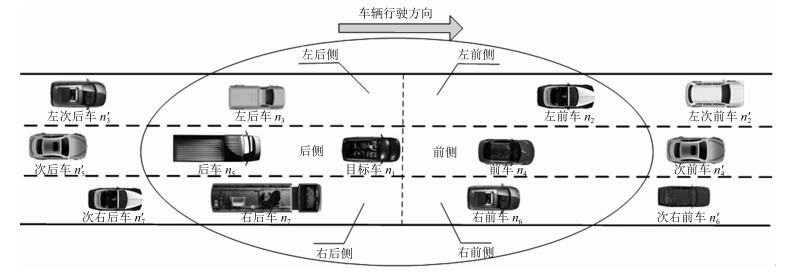
 下载:
下载:

